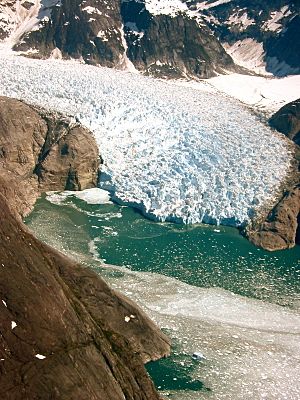LeConte Glacier facts for kids
LeConte Glacier is a huge river of ice in Alaska, United States. It is about 21-mile (34 km) long and 1-mile (1.6 km) wide! This amazing glacier flows southwest into a deep bay called LeConte Bay.
History and Name
The glacier was named in 1887 by a U.S. Navy officer, Charles M. Thomas. He named it after Joseph LeConte, a biologist from California. The local Tlingit people had their own name for it: "Huti." They believed this name came from a mythical bird. This bird was said to make thunder sounds when it flapped its wings!
Special Features
LeConte Glacier is unique because it is the southernmost tidewater glacier in the entire Northern Hemisphere. A tidewater glacier is one that flows directly into the ocean.
This glacier is famous for its "shooter" icebergs. These are pieces of ice that break off, or "calve," from the glacier. They break off underwater because LeConte Bay is very deep, about 810 feet (250 m)! Because ice is lighter than water, these icebergs shoot up out of the water like rockets. It's an amazing sight to see!
Scientists have also learned something new about this glacier. In 2019, they found that the underwater part of LeConte Glacier melts much faster than they thought.
Visiting the Glacier
LeConte Glacier is a popular place for tourists to visit. Boats from nearby towns like Petersburg and Wrangell take people to see the glacier's calving face. This is where the ice breaks off into the bay.
Students from Petersburg High School also visit the glacier often. They help scientists keep track of how much the glacier has shrunk over time.
The M/V LeConte Ferry
There is also a ferry named after the glacier. It is called the M/V LeConte. This ferry is part of the Alaska Marine Highway system, which helps people travel between different towns in Alaska.


